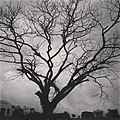Paranthropus boisei
Paranthropus boisei is an extinct human ancestor that lived in the savannah environment of East Africa from 2.3 million until 1.2 million years ago. It is the most robust form of the robust australopithicenes, and is specialized towards heavy chewing.
The first specimen OH 5 was found by Mary Leaky at Olduvai Gorge in 1959 after 28 years of searching. It was originally named Zinjanthropus boisei or Nutcracker man, named so for its large molars and small anterior teeth. It was later renamed Paranthropus boisei, although it is also often called Australopithecus boisei. [1]
Phylogeny
Paranthropus boisei is not actually a human ancestor but rather a cousin. It was most likely descended from Paranthropus aethipicus and some scientists consider it a subspecies of Paranthropus robustus. Many of its features are similar to Australopithecus africanus. "Paranthropus boisei" is part of the family Homididae. [2]
Scientific Classification
Kingdom- Anamalia Phylum- Chordata Class- Mammalia Order- Primates Family- Homididae Genus- Paranthropus Species- Paranthropus boisei
Characteristics
Crania and Dentition
There are several characteristics that are obviously Paranthropus boisei, primarily in the craniuma and dentition, such as:
- Prognathic lower face
- Post-Orbital constriction reduced
- Infraorbital foramen location is variable
- Occipital Marginal sinus present
- Infrolateral orbital margin reduced
- Mental foramen opening is variable
- Lingual cusps at [margin-bucca cusps] approaching internal
- Tympanic crest with inclined plate
- Sagittal crest on mid-brain case in males
- Maxillary trigon variable
- Upper incisor reduced
- Molar cusps and cristae well developed
- Thin and delicate wall on cranium [3]
- Cranial capacity of 450-600cc
- Large molars
- Large incisor alveolae
- Ape-like Cranial base
- Zygomatic arch of skull is wide and thick, indicating powerful masseter muscles [4]
- Shortening of the base and decrease in the angle of the petrous pyramids
- Megadontia quotient of 2.7
- Encephalization quotient of 2.7
Post-cranial anatomy
Postcranially, Paranthropus boisei is obviously bipedal. The thigh bone is set at a low angle to the shaft, with the shaft flattened from front to back, and there is a small hip joint surfact; all of these traits lead to better ballance. The pelvis is more human than chimpanzee: it is shortened and widened. The arms and thumbs appear to be similar to Homo habilis, and Paranthropus boisei probably had an excellent precision grip. Males were probably about 4'6" weighing 90-100 pounds, females were 3'6" weighing about 60-70 pounds. [5]
Diet
Small anterior teeth and large molars, as well as the wear patterns on the teeth suggest that Paranthropus boisei ate hard and fiborous foods such as nuts. It also suggests that they ate a lot of food rich in 13C foods found in savannahs and wetter areas. This food would include meat. The animals they were eating were most likely scavanged though, because while there are stone tools found at the sites with Paranthropus boisei, most scientists tie these stone tools to Homo habilis as they had larger brains and are more closely related to humans.[6]
Environment
Paranthropus boisei fossils are found near ancient lakes and streams. They lived in savannah environments, forests, and flooded grasslands. Some of the animals found in the fossil beds with them are giant gelda baboon, clawless otter, white rhinoceros, black rhinoceros, bush pig, warthog, giraffe, large kudu, hartebeest, topi, wildebeest, sable antelope, springback, Grant's gazelle, two species of extinct buffallo, and four species of extinct pig.
Some of the sites they have been found at are the upper level of Bed 1 and Bed 2 at Olduvai Gorge, Upper Burgi, Okote Members of Koobi Fora Formation in East Lake Turkana, Member G of the Shangura Formation along the Omo River, and the Ethiopian Rift.
Specimens
OH5
OH5 was the first specimen of "Paranthropus boisei" found by Mary Leakey at Olduvai Gorge in Tanzania. It is nicknamed the "Nutcrackerman". It was an adult male specimen dating to around 1.75 million years ago.
KNM-ER 406
KNM ER 406 is a small partial cranium discoverd by H. Mutua and Richard Leakey in 1969 at Koobi Fora, Kenya. It has large zygomatic arches and cranial capacity of 510 cc. It is dated to about 1.7 million years ago.
ER 406
ER 406 was found by R. Leakey and H. Mutua in 1970 at Koobi Fora, Kenya. It is a female partial cranium dating to 1.7 million years ago. [7]
- ↑ Paranthropus Boisei, http://anthropology.si.edu/HumanOrigins/ha/bos.html, [March 3], [2008]
- ↑ Extinct Humans, Ian Tattersall and Jeffrey Schwartz, Westview Press, New York, 2007
- ↑ Bones, Stones, and Molecules, David Cameron and Colin Grons, Elsevier Academic Press, London, 2004
- ↑ Evolution of the Human Diet, Peter Ungar, Oxford University Press, NYC, 2007
- ↑ The Last Human, G.J. Sawyer and VIktor Peak, Yale University Press, New Haven, Ct., 2007
- ↑ Ungar, pg. 140
- ↑ "Australopithecus boisei" http://archaeologyinfo.com/australopithecusboisei.htm, 2005, 4/2/2008


